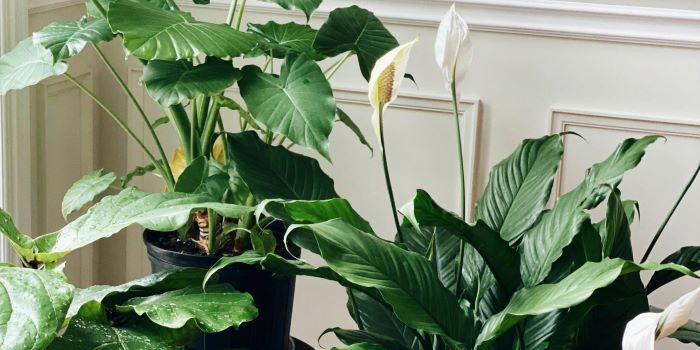With their lush green leaves and beautiful white blooms, peace lilies make a wonderful addition to any home. Native to tropical rainforests, these plants thrive indoors with some basic care and maintenance. In this article we talk about Peace Lily Care – How to Maintain Beautiful Blooms and Glossy Leaves.
Light

Peace lilies grow best in bright, indirect light. Direct sunlight will scorch their leaves, causing brown crispy spots, so keep them in a north or east facing window out of harsh afternoon light. Low light will lead to fewer blooms. The perfect peace lily location has bright ambient room light but no several hours of direct sun rays.
Water
Peace lilies like consistently moist (but not soggy) soil. Allow the top inch of soil to dry out between waterings then soak the pot completely. Use room temperature filtered water for the healthiest plants. Cold tap water may shock their tropical roots. Be sure the pot has drainage holes on the bottom and discard any water that collects in the saucer so the plant doesn’t sit in standing water.
Soil
Use a well-draining potting mix formulated for tropical houseplants. Standard potting soil is often too heavy. Look for mixes containing peat moss, perlite and vermiculite that will hold some moisture but still drain well. Re-pot every 2 years in fresh potting mix to replenish nutrients.
Fertilizer
While peace lilies can tolerate low fertility soils, they will reward you with faster growth, lush leaves and more blooms with regular feeding. Use a balanced liquid fertilizer diluted to 1/2 strength every 2-4 weeks during spring and summer. Discontinue feeding over winter when light levels drop.
Humidity
As tropical rainforest natives, peace lilies thrive in humidity levels between 60-80%. In dry indoor environments, they are prone to brown leaf tips and margins. Set pots on pebble trays filled with water to increase local humidity. Misting leaves daily also helps but does not increase overall room humidity significantly. For the healthiest peace lilies, use room humidifiers to maintain humidity.
Pruning
Remove spent peace lily flowers by snipping the stems near the base of the plant. This neatens appearance and prevents the plant from putting energy into seed production. Prune off any yellow or brown leaves to keep your plant looking its best. As long as the crown of the plant (where leaves emerge from the soil) looks healthy, peace lilies can tolerate aggressive pruning of damaged foliage.
Blooming
Peace lilies generally bloom in spring and summer. They produce long-lasting white spathes that surround the spadix—a column containing small flowers. Each spadix can produce hundreds of tiny blooms! Peace lily flowers emerge pure white and gradually fade to green or yellow as they age. Higher light levels promote more frequent blooming.
Troubleshooting Problems
Following the basic care guidelines should result in a vigorous peace lily. But these plants can suffer if conditions are not to their liking. Here are some common peace lily problems and their solutions:
- Brown leaf tips – Increase humidity
- Brown spots on leaves – Move out of direct sunlight
- Failure to bloom – Provide bright indirect light
- Yellow leaves – Ease up on fertilizer, avoid overwatering
- Wilting – Water more frequently, check roots for pests
- Drooping leaves – Increase light exposure, water more
With the right care, peace lilies make excellent long-lived houseplants. Their graceful blooms and easygoing nature have made them popular for decades. Just be sure to provide them the light, water and humidity they need to really flourish.
Keeping Your Peace Lily Thriving for Years
Caring properly for your peace lily will keep it growing strong for 5 years or longer. Here are some extra tips to help your plant thrive:
- Wipe leaves down monthly with a damp cloth to keep them dust-free and vibrant.
- Rotate the pot every few weeks to ensure even growth on all sides.
- Remove spent flowers consistently to promote new blooms.
- Apply worm castings or compost tea a few times a year as a nutrient boost.
- Monitor for pests like aphids, mealybugs and spider mites and treat any infestations promptly.
- Talk or sing to your plant as studies show plants may grow better with positive speech!
With the easy, natural care methods outlined here, anyone can have a gorgeous peace lily brightening up their living spaces for years to come. These plants repay proper care with graceful blooms emerging from lush, deep green foliage. Peace lilies strike the perfect balance between elegant and easygoing. I sincerely hope you find this “Peace Lily Care – How to Maintain Beautiful Blooms and Glossy Leaves” article helpful.
If you enjoyed this article, you might also like this one: Onion Companion Plants Care

Holding a Ph.D. in Botany and boasting over 15 years of experience in horticulture and plant science, our author stands as a top authority on plant care and gardening. Their dedication to sustainable gardening practices and thriving greenery shines through on egreenplants.com, where they share their extensive knowledge and personal insights. Whether it’s mastering plant cultivation techniques or offering expert advice on plant care, their guidance ensures gardening enthusiasts receive reliable and actionable information. Follow their green journey on Instagram at @plantsandrocks for more tips and inspiration.

